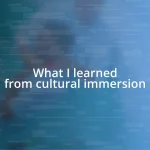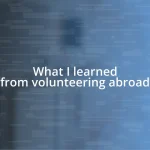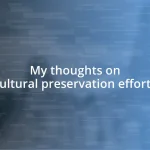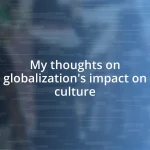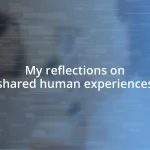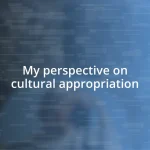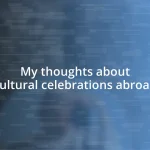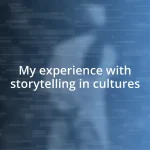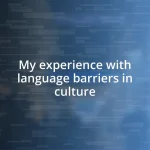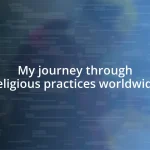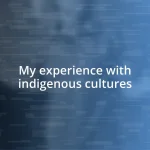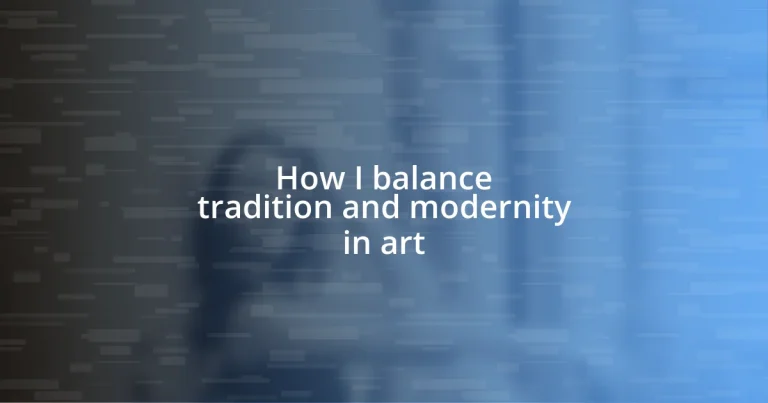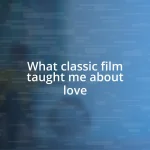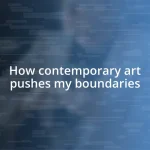Key takeaways:
- Tradition in art involves both honoring historical techniques and evolving creatively, emphasizing the emotional connection to cultural practices.
- Modern art represents innovation and a dialogue with the past, allowing artists to address contemporary issues while reinterpreting classical themes.
- Globalization enriches the art world through diverse influences and collaborations, though it also poses challenges regarding authenticity and cultural identity.
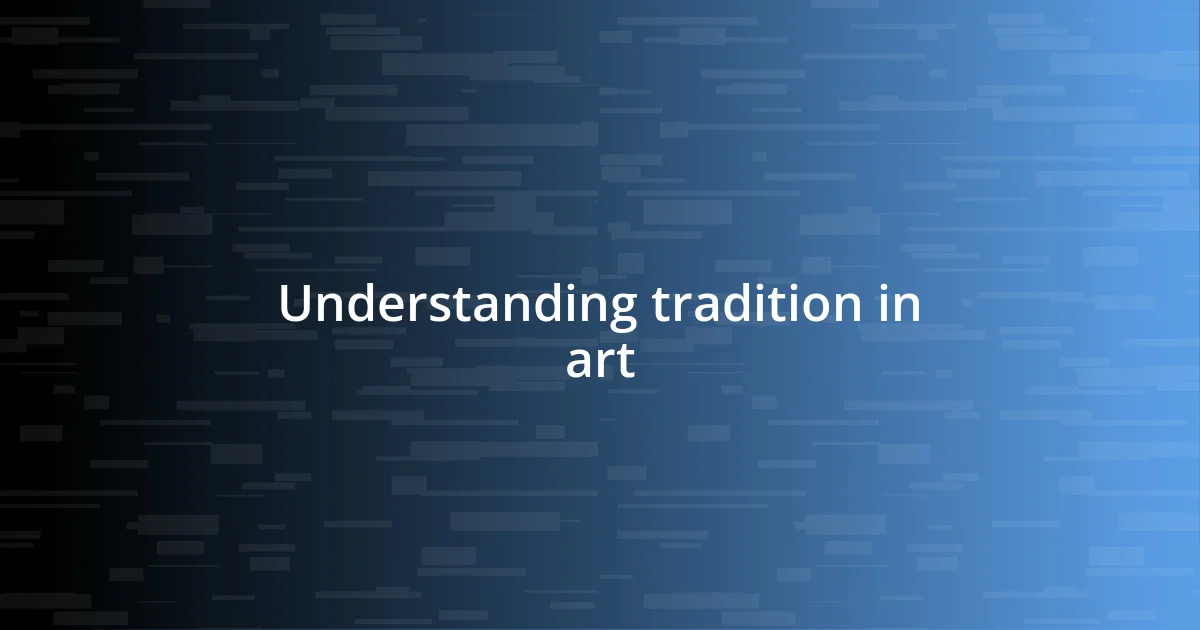
Understanding tradition in art
When I think about tradition in art, I often recall my first visit to an ancient art gallery. The walls were adorned with pieces steeped in history, showcasing techniques passed down through generations. These artworks whispered stories from times long gone, making me wonder: how do we honor these traditions without losing our own voice?
Tradition in art isn’t just about replication; it’s about interpretation and evolution. I remember experimenting with traditional techniques in my own projects, feeling both the weight of history and the thrill of innovation. Isn’t it fascinating how a single brushstroke, grounded in tradition, can open up new avenues for expression?
For me, understanding tradition involves an emotional connection—it’s the feeling of belonging to something greater. I often reflect on the cultural practices that shape our artistic identities. How can we balance this rich heritage while still pushing our creative boundaries? In my experience, the answer lies in acknowledging where we come from and using that foundation to explore new horizons.
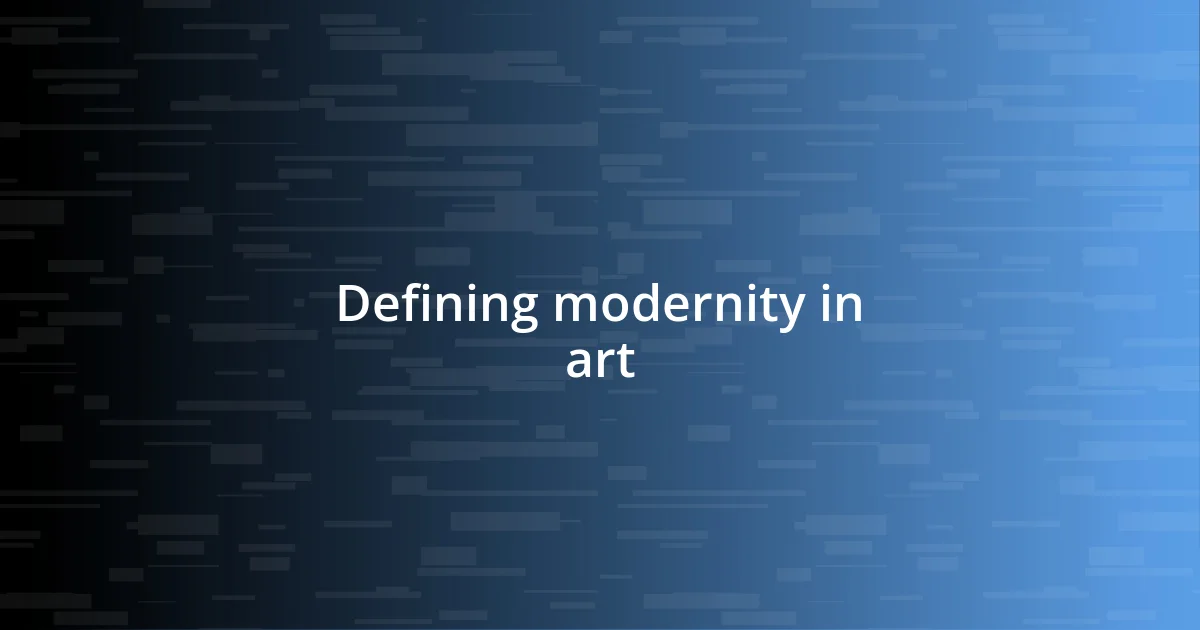
Defining modernity in art
Defining modernity in art requires a shift in perspective. I often view modernity as a celebration of innovation, where artists break away from traditional constraints to explore new materials and ideas. For instance, when I experimented with mixed media in my work, I felt liberated. The canvas wasn’t just a surface anymore; it became a playground for my imagination, blending paint, fabric, and found objects.
Modern art is not merely a rejection of the past but rather a dialogue with it. I remember attending an art exhibition that showcased contemporary interpretations of classical themes. It was inspiring to see how artists redefined landscapes, figures, and emotions, merging classical techniques with modern contexts. This fusion sparked my own creativity; it taught me that embracing modernity doesn’t mean erasing tradition—it means reimagining it.
Moreover, I believe that modernity in art embodies a sense of urgency and relevance. As we navigate today’s world, my art reflects social issues, personal experiences, and cultural dialogues. When I create pieces that respond to current events, I feel a powerful connection to the audience, reminding me of the role of an artist in shaping conversations. Isn’t it intriguing how modern art serves as both reflection and catalyst in our rapidly changing society?
| Aspect | Traditional Art | Modern Art |
|---|---|---|
| Approach | Adherence to established techniques and cultural practices | Experimentation and innovation |
| Materials | Natural pigments, wood, canvas | Mixed media, digital, unconventional materials |
| Themes | Cultural heritage, historical narratives | Contemporary issues, personal expression |
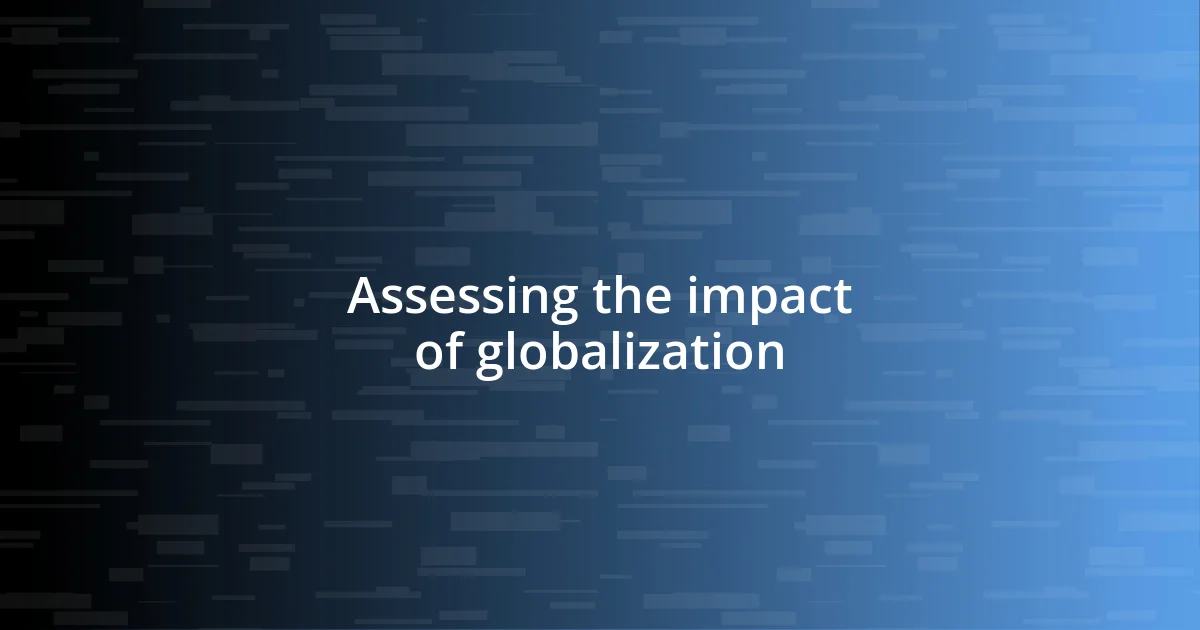
Assessing the impact of globalization
Globalization has profoundly influenced the art world, merging diverse traditions and modern expressions. I recall a visit to an international art fair that showcased artists from varying cultural backgrounds. It struck me how globalization not only expanded our artistic horizons but also sparked vibrant dialogues among different traditions. Artists from seemingly distant corners of the globe conversed through their work, bridging gaps and fostering mutual understanding.
Here are some key impacts of globalization on art:
- Access to Diverse Influences: Artists can now draw inspiration from global cultures, which can enhance their work’s richness and depth.
- Crossover Collaborations: My experience collaborating with a musician from another country taught me the beauty of blending artistic forms and traditions. These collaborations can lead to innovative, hybrid art styles.
- Cultural Exchange Platforms: Global exhibitions and online galleries facilitate the exchange of ideas and philosophies, enriching both traditional and modern art practices.
- Market Dynamics: The global market has transformed how we view art—the internet allows artists to reach larger audiences, redefining the concept of local versus global art.
- Challenges to Authenticity: Navigating myriad influences can sometimes dilute traditional practices, leading to concerns about authenticity in artistic expressions.
As I reflect on these aspects, I find myself at a crossroads—embracing the global flow while cherishing the local roots. The challenge lies in honoring these influences without losing our distinct artistic identities.
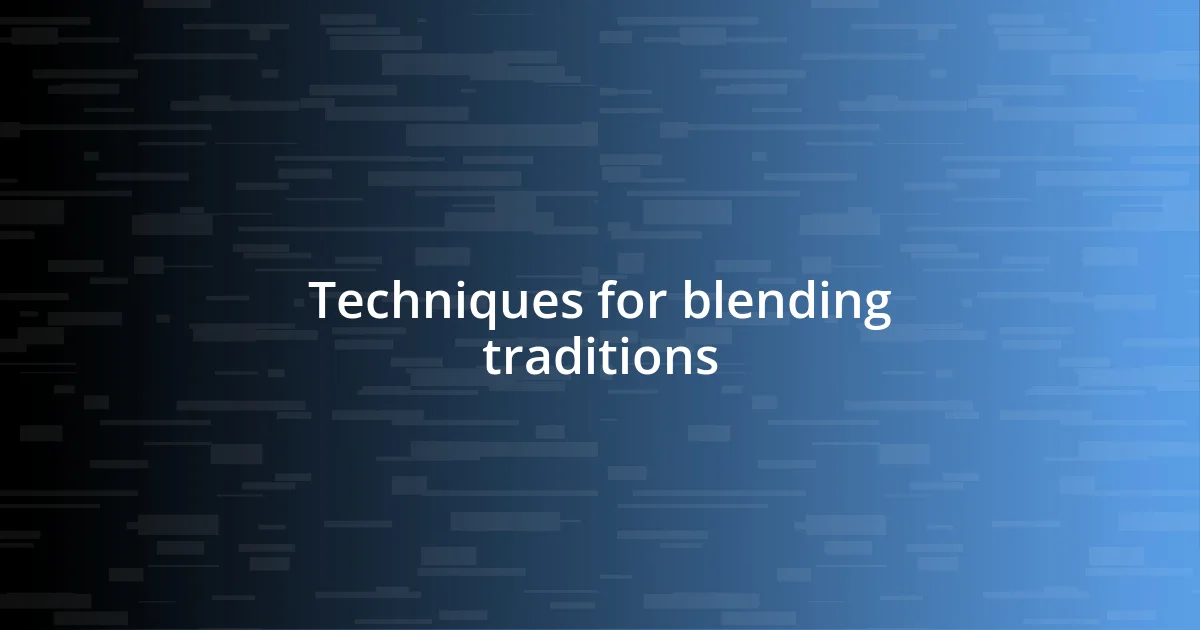
Techniques for blending traditions
Blending traditions in art can be an exhilarating journey, and one of the techniques I often employ is layering techniques. For instance, when I paint, I sometimes start with a traditional method, like fine brushwork inspired by classical portraiture, and then overlay it with bold strokes of contemporary abstraction. This approach creates a dialogue between old and new, allowing viewers to appreciate the depth of both styles. Have you ever tried layering your creative processes? It can lead to unexpected and remarkable results.
Another technique that genuinely fascinates me is incorporating symbols from different cultural backgrounds. Recently, while working on a piece that reflects my heritage, I added motifs from Eastern art alongside Western techniques. The resulting artwork not only conveyed my personal narrative but also sparked conversations about shared cultural histories. I find it compelling how art can transcend boundaries; it’s almost as if each symbol tells a story of its own, inviting viewers to delve deeper into their meanings.
Lastly, experimentation with materials can be a bridge between tradition and modernity. I recall the time I took a traditional Japanese woodblock printing technique and adapted it using modern digital tools. The blend yielded a striking visual contrast that honored the past while embracing the swift pace of today’s world. It made me realize that the materials we choose can become our voice in this ever-evolving dialogue. How do you choose your materials? The right choice can lead you to blend your artistic traditions seamlessly into the present.
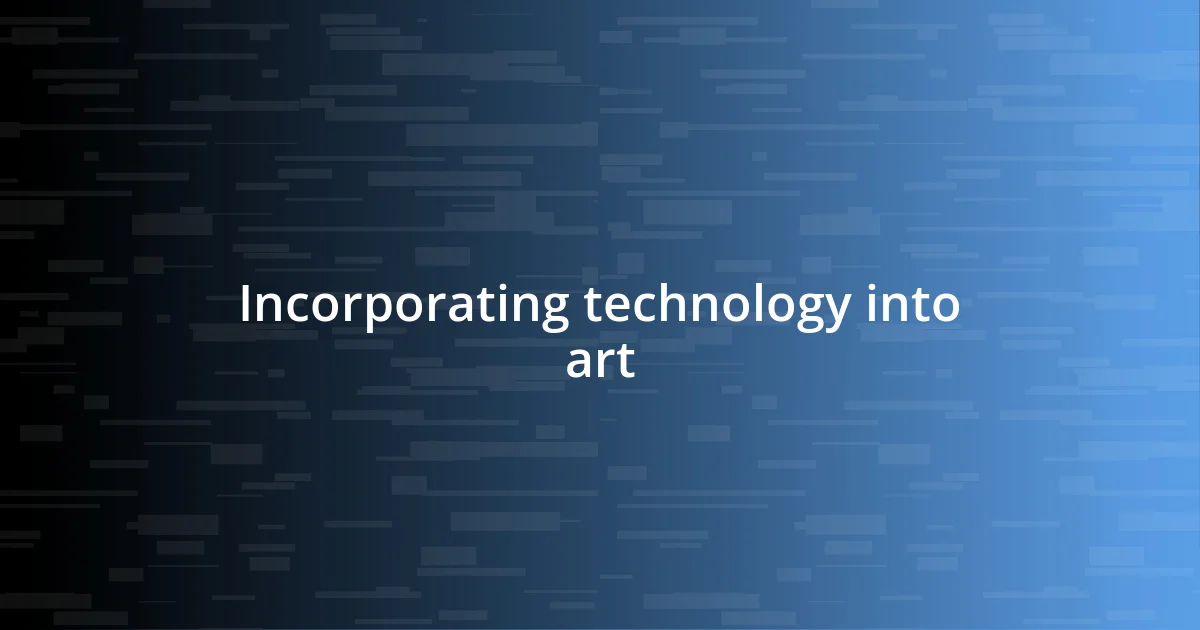
Incorporating technology into art
In recent years, I’ve been fascinated by how technology intertwines with artistic expression. I remember one project where I used a digital drawing tablet to create a piece that seamlessly combined hand-drawn sketches with digital enhancements. The immediacy and flexibility of technology allowed me to experiment freely—each time I made a change, I could instantly see its effect, creating a dynamic conversation between tradition and innovation. Have you ever found yourself captivated by the possibilities technology offers in your artistic practice?
One striking example of incorporating technology into art is the use of augmented reality (AR). During a recent exhibition, I was excited to see how AR brought traditional paintings to life, letting viewers engage in a way I had never experienced before. The ability to display animations and additional layers of information transformed the art into a multidimensional experience. It made me wonder—how might AR change our perceptions of traditional art forms in the future? I truly believe that these technological advancements create new avenues for storytelling and connection.
Moreover, I often reflect on the role of social media as a platform for sharing art. When I first started posting my creations online, I was amazed by the feedback from a global audience. This instant interaction not only motivated me but also influenced my creative choices. Suddenly, the traditional gallery setting felt a bit restrictive compared to the whirlwind of ideas and community engagement online. Isn’t it thrilling how technology can help us connect with fellow artists and enthusiasts, transcending geographical boundaries? Adopting these technologies in my art practice has brought fresh perspectives and deeper connections that continually inspire me.
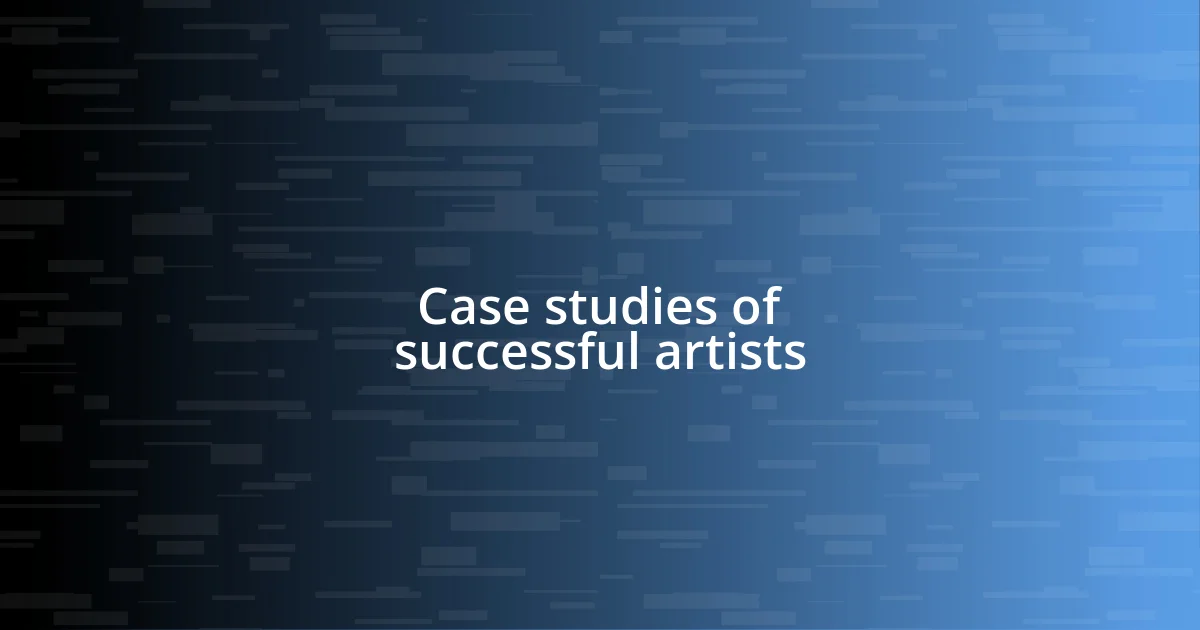
Case studies of successful artists
One artist who embodies the successful melding of tradition and modernity is Ai Weiwei. His work often references ancient Chinese art forms while criticizing contemporary societal issues. I recall the first time I encountered his installations that utilized traditional Chinese porcelain—each piece shattered and reassembled in a new context. It struck me deeply, evoking a sense of loss and resilience. Have you ever experienced how an artwork can simultaneously honor the past and challenge the present?
Another captivating example is Kehinde Wiley, known for his vibrant portraits that place contemporary subjects in poses reminiscent of classical portraiture. I fondly remember seeing one of his pieces in a gallery—an everyday man draped in regal attire, surrounded by lush, splattered backgrounds. The blend of styles was powerful, inviting me to reconsider who gets represented in art history. Don’t you find it invigorating when artists challenge established norms while paying homage to traditional forms?
Finally, I think of the incredible journey of Yinka Shonibare. His use of Dutch wax fabric makes a bold statement about colonial history and identity. When I saw his life-sized sculptures dressed in Victorian fashion, I felt an electric connection to the layered narratives he was conveying. It made me ponder: how do our choices in subject matter and materials reflect our complex identities? Shonibare’s capacity to weave together conversations of past and present makes his work truly compelling and thought-provoking.
